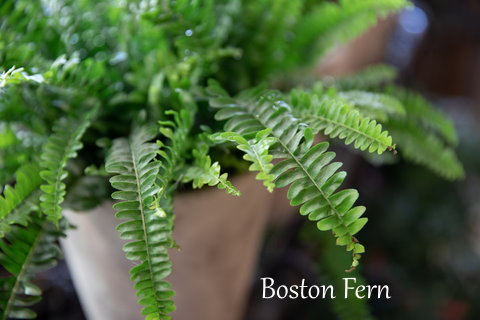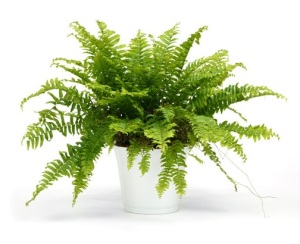Growing Boston Fern Indoors: Nephrolepsis exaltata Care Tips
Botanical Name: Nephrolepsis exaltata
Boston ferns are the most popular of the fern species that originated in Central America and became a fast favorite in parlors and porches in North America during the Victorian era.
Long, arching fronds densely covered with leaflets — called pinnae — makes this lush, graceful house plant ideal for a pedestal or a hanging basket.
 Boston ferns make handsome tropical houseplants. Photo: © Kurylo54
Boston ferns make handsome tropical houseplants. Photo: © Kurylo54Buying Boston Ferns
Garden centers display hanging baskets of ferns in spring and summer. You may find ferns for sale at online flower shops, too. Look for a fern with new fronds unfurling from the center — a sure sign of a healthy plant.
Today, there are several new cultivars that are getting attention, including ‘Fluffy Ruffles’ with curly fronds and a dwarf variety ‘Timii’ that makes an elegant table accent.
Caring for Boston Fern Indoors
Caring for Boston ferns is easy, as long as you meet their need for high humidity. Ferns are native to tropical rainforests, where the relative humidity stays well above 70%. Short of turning your home into a misty rainforest, there are a few things you can do to raise the humidity for your plant.
Brown leaflets — or pinnae — are often caused by dry air. Avoid placing your fern near a heat or AC vent because fluctuations in temperature can shock the plant and also cause browning of leaflets. Some browning of frond tips is normal. You can trim brown leaflets with scissors, if you want, to keep it looking neat. Older, lower fronds will naturally turn brown when they die and should be cut off.
Fronds that are yellow and wilted are a sign of overwatering. Reduce amount of water and trim off damaged fronds. Use a container with drainage holes to prevent soggy soil. Check the plant’s roots to see if they have rotted. If the roots are mostly black, get rid of it — it’s too far gone.
Repot in spring, when the roots have filled the container. Move the fern to a pot that’s only slightly larger. Want to control its size? Remove the fern from its container and prune off about 1/4 of its roots. Then repot it in the same pot it was in before. This is a good time to divide the fern, if you want.
Are Boston ferns poisonous to cats and dogs? No. According to the ASPCA, this common fern is non-toxic to pets.
A couple pests bother this fern. Watch for scale, that look like small, brown discs on leaflets. (Sometimes the brown spores on the undersides of leaflets are mistaken for scale insects. You’ll recognize the spores because they appear in two rows under each pinnae.) To remove scale insects, scrape them off with your fingernails. Don’t use insecticides on ferns because they are easily damaged by chemicals.
Spider mites are less common, but can cause more damage. Fine webbing between fronds are a sure sign of this destructive pest. Cut off badly affected fronds. Don’t use an insecticide, which can damage fronds. If it’s warm enough, you can take your fern outdoors to wash it off with tepid water to dislodge these mites. Otherwise, place your fern in the shower.
Misting your fern regularly will prevent an invasion of spider mites that prefer drier conditions. And your fern will love the humidity.
Boston Fern Care Tips

Origin: Central America
Height: Fronds are generally 1-3 ft (30-90 cm) long.
Light: Bright, indirect light. No direct sun. Give the plant a quarter turn every week or so to expose all sides to light.
Water: Keep soil constantly moist, but not soggy. Watch large ferns and hanging basket ferns because they can dry out quickly. Wilted or drooping fronds are caused by either under- or over-watering. Always use room-temperature water for your houseplants; Cold water is a shock to these tender tropicals.
Humidity: Try to maintain moist air (around 40-50% relative humidity) near the fern. Use a room humidifier for best results. Misting with room-temperature water helps, if you can mist a few times a day.
Temperature: Normal room temperatures 65-75°F/18-24°C
Soil: Peat moss-based potting mix, such as African violet potting mix. Or half-half mixture of peat moss and all-purpose potting mix.
Fertilizer: Feed every 2 weeks year-round with a balanced water-soluble fertilizer diluted by half.
Propagation: Division. You can cut away new plants that grow outside the main root ball and pot them separately. Or divide a large root ball into smaller clumps with a sharp knife and pot them up.




